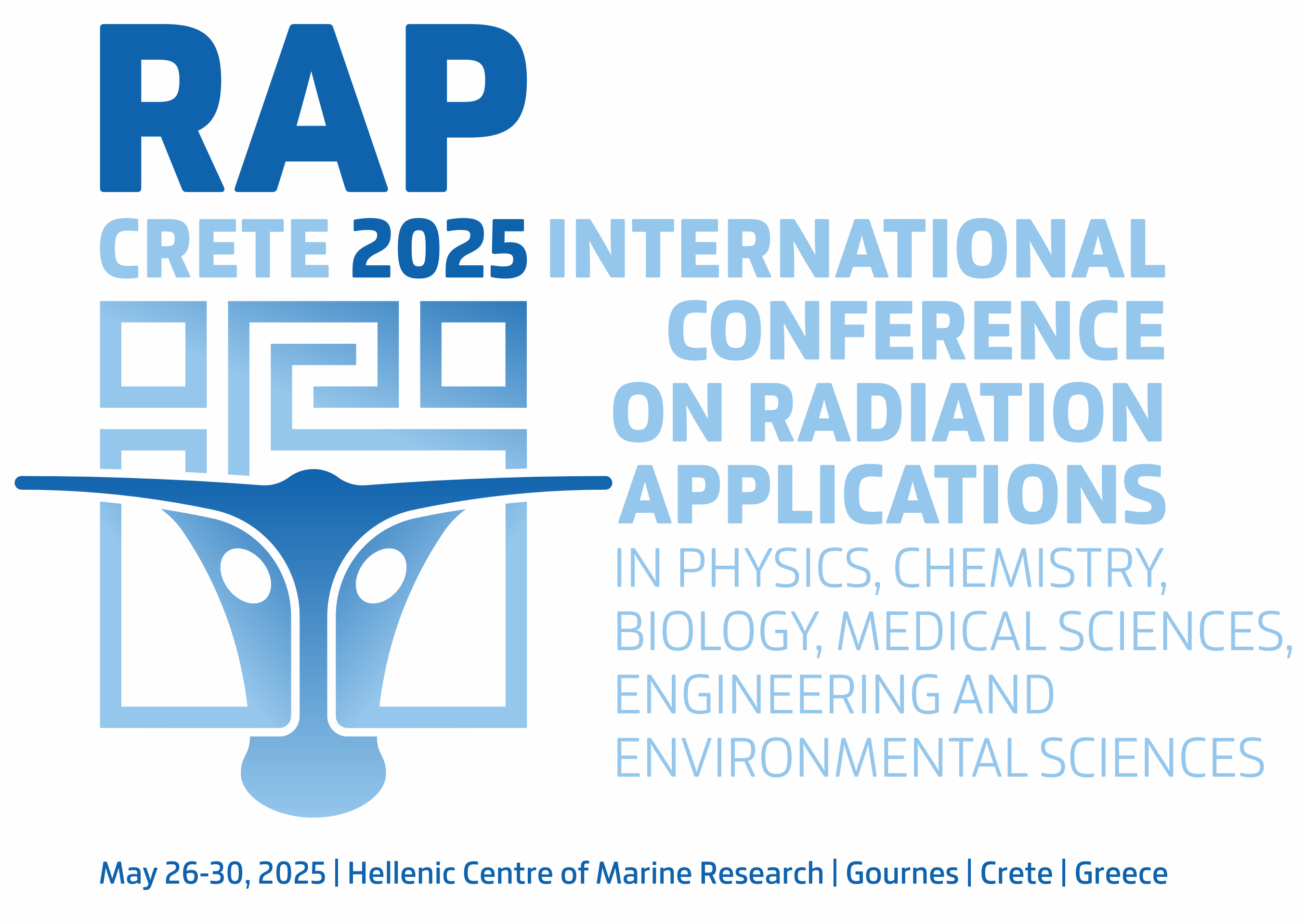Vol. 8, 2023
Environmental Chemistry
CONCENTRATION OF SELECTED RADIONUCLIDES IN HIGH DUST DEPOSITION AREA: CONSIDERATION OF DEPLETED URANIUM
Abdulaziz Aba, Omar Al-Boloushi, Anfal Ismaeel
Pages: 91-96
DOI: 10.37392/RapProc.2023.19
Abstract | References | Full Text (PDF)
Fallen dust samples from ten Northern Arabian Gulf locations were analyzed
for natural radionuclides and 137Cs using ultra-low background
gamma spectrometry. A dust trap of 20 cm diameter collected the samples
from ten sites in Kuwait, enabling the determination of radionuclide
concentrations. Direct measurement of 234Th estimated
238
U, while the 235U concentration was calculated using the sum
peak of 226Ra and 235U of 186 keV gamma line. The
calculation of the uranium activity ratio showed that the sample contained
natural levels of uranium isotopes. The average concentration of various
radionuclides demonstrated significant variation. The median concentrations
of7Be, 137Cs, 210Pb, 40K,
224
Ra, 226Ra, 228Ra and 234Th were 1113 ±
148, 11.7 ± 0.6, 434 ± 27, 357 ± 6, 23.4 ± 1.7, 20.2 ± 1.5, 12 ± 2 and
44 ± 1.8 mBq g-1respectively. The measured activity ratios of
137Cs/40K and 7Be/210Pb
confirmed the effects of the regional dust sources.
-
A. Al-Hemoud et al., “Health impact assessment associated with exposure to
PM10 and dust storms in Kuwait,” Atmosphere, vol. 9, no. 1, 6,
Jan. 2018.
DOI: 10.3390/atmos9010006 -
A. Aba, A. Ismaeel, A. Al-Boloushi, H. Al-Shammari, O. Al-Boloushi,
“Deposited Rates of Radionuclides,” in
Atlas of Fallen Dust in Kuwait, A. Al-Dousari, Eds., 1 st ed., Cham, Switzerland: Springer
Cham, 2021, ch. 6, pp. 140 – 176.
DOI: 10.1007/978-3-030-66977-5_6 -
A. Al-Hemoud et al., “Sand and dust storm trajectories from Iraq
Mesopotamian flood plain to Kuwait,” Sci. Total Environ., vol.
710, 136291, Mar. 2020.
DOI: 10.1016/j.scitotenv.2019.136291
PMid: 31911252 - What are the WHO Air quality guidelines? Improving health by reducing air pollution, WHO, Geneva, Switzerland, 2021.
-
A. Al-Dousari, N. Al-Dousari, “Deposited Dust,” in
Atlas of Fallen Dust in Kuwait, A. Al-Dousari, Eds., 1 st ed., Cham, Switzerland: Springer
Cham, 2021, ch. 2, pp. 47 – 56.
DOI: 10.1007/978-3-030-66977-5_2 -
H. Bem, F. Bou-Rabee, “Environmental and health consequences of depleted
uranium use in the 1991 Gulf War,” Environ. Int., vol. 30, no. 1,
pp. 123 – 134, Mar. 2004.
DOI: 10.1016/S0160-4120(03)00151-X
PMid: 14664872 -
E. G. Daxon et al.,
Health and Environmental Consequences of Depleted Uranium Use in the
U.S. Army: Technical Report, Rep. AEPI-0038, AEPI, Atlanta (GA), USA, 1995.
Retrieved from: https://www.academia.edu/25782366/Health_and_Environmental_Consequences_of_Depleted_Uranium_Use_in_the_U_S_Army_Technical_Report
Retrieved on: May 18, 2023 -
M. A. McDiarmid et al., “Health effects of depleted uranium on exposed Gulf
War veterans: a 10-year follow-up,”
J. Toxicol. Environ. Health Part A, vol. 67, no. 4, pp. 277 – 296, Feb. 2004.
DOI: 10.1080/15287390490273541
PMid: 14713562 -
A. Bleise, P. R. Danesi, W. Burkart, “Properties, use and health effects of
depleted uranium (DU): a general overview,” J. Environ. Radioact.,
vol. 64, no. 2-3,
pp. 93 – 112, 2003.
DOI: 10.1016/s0265-931x(02)00041-3
PMid: 12500797 -
Z. Hon, J. Österreicher, L. Navrátil, “Depleted uranium and its effects on
humans,” Sustainability, vol. 7, no. 4, pp. 4063 – 4077, Apr.
2015.
DOI: 10.3390/su7044063 -
R. R. Parrish et al., “Depleted uranium contamination by inhalation
exposure and its detection after ∼ 20 years: Implications for human health
assessment,” Sci. Total Environ., vol. 390, no. 1, pp. 58 – 68,
Feb. 2008.
DOI: 10.1016/j.scitotenv.2007.09.044
PMid: 17976690 -
L. W. Luckett, “Radiological conditions in areas of Kuwait with residues of
depleted uranium,” Health Phys., vol. 90, no. 2, pp. 180 – 181,
Feb. 2006.
DOI: 10.1097/00004032-200602000-00011 -
A. F. Elsayed, M. T. Hussein, S. A. El-Mongy, H. F. Ibrahim, A. Shazly,
“Different Approaches to Purify the 185.7 keV of 235U from Contribution of
Another Overlapping γ-Transition,” Phys. Part. Nucl. Lett., vol.
18, no. 2, pp 202 – 209, Mar. 2021.
DOI: 10.1134/S1547477121020060 -
A. Aba, A. Ismaeel, “Preparation of in-house calibration source for the use
in radioactivity analysis of the environmental samples: consideration of
homogeneity,” J. Radioanal. Nucl. Chem., vol. 295, no. 1, pp. 31 –
38, Jan. 2013.
DOI: 10.1007/s10967-012-1893-9 -
R. L. Lozano et al., “Mesoscale behavior of 7Be and 210Pb in superficial
air along the Gulf of Cadiz (south of Iberian Peninsula),”
Atmos. Environ., vol. 80,
pp. 75 – 84, Dec. 2013.
DOI: 10.1016/j.atmosenv.2013.07.050 -
Y. Y. Ebaid, S. A. El-Mongy, K. A. Allam, “235U–γ emission contribution to
the 186 keV energy transition of 226Ra in environmental samples activity
calculations,” Int. Cong. Ser., vol. 1276, pp. 409 – 411, Feb.
2005.
DOI: 10.1016/j.ics.2004.12.020


